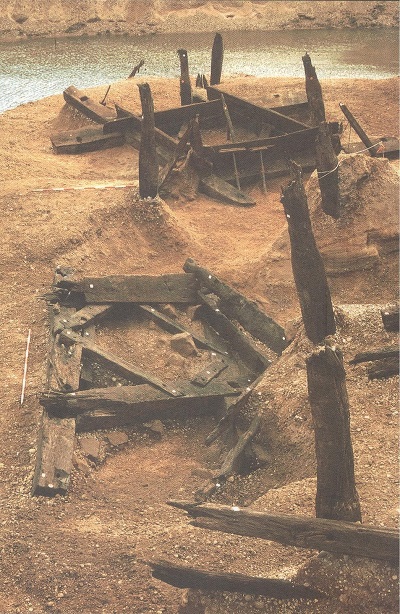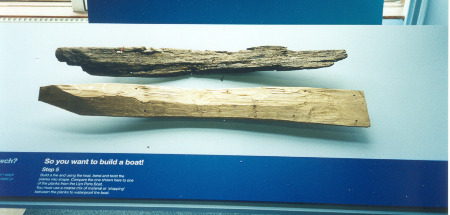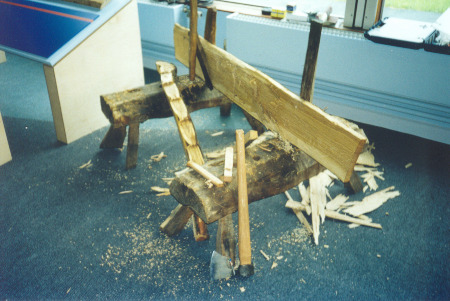Medieval
2. Oak Coffins from Hull Magistrates Court
4. Dragon Hall
5. Chapel Nave Roof - Jesus College Cambridge
1. The Hemington Bridges
Three medieval bridges were uncovered in Leicestershire. They were
built in the 11th, 12th and 13th centuries. Richard prepared two
chapters for the subsequent report.
Tools and Joint Types
The toolmarks found on the excavated timber gives information about
the methods used to shape the timber and the characteristics of
the tools used. The tools used are the same in all three bridges;
however the woodworking techniques are different between the
earliest bridge and the later bridges. The early bridge uses
Anglo-Norman techniques, while the late bridge uses medieval
techniques.

Hemington Bridge - a joint. The pale sponge is keeping moisture in the mortice hole. Photo © Richard Darrah.
Sources and Conversion of the Trees
The 11th and 13th century bridges provide most of the evidence.
There is no difference in the source or conversion of the timber
between bridges. The timber appears to come from both dense
woodland and from hedgerow trees. The timber is not the best
quality, but was chosen for its suitability for the job. The trees
were felled with axes and both radial splitting and hewing were
used.

Displaced caisons from Hemington Bridge under excavation. Photo © English Heritage.
Ripper S and Darrah R. Bridge 1: The late 11th to early 12th Century Bridge, chapter 3. In: Ripper, S and Cooper LP (2009)., The Hemington Bridge: the excavation of three medieval bridges at Hemington Quarry near Castle Donington, Leicestershire. Leicester Archaeology Monograph 16. Bristol, University of Leicester Archeaological Services.
Darrah R. The tools and joint types used in the construction of the Hemington Bridges, chapter 7. In: Ripper S and Cooper LP (2009)., The Hemington Bridge: the excavation of three medieval bridges at Hemington Quarry near Castle Donington, Leicestershire. Leicester Archaeology Monograph 16. Bristol, University of Leicester Archeaological Services.
Darrah R. Sources and conversion of the trees used in the Hemington Bridges, chapter 8. In: Ripper S and Cooper LP (2009)., The Hemington Bridge: the excavation of three medieval bridges at Hemington Quarry near Castle Donington, Leicestershire. Leicester Archaeology Monograph 16. Bristol, University of Leicester Archeaological Services.
2. Oak Coffins from Hull Magistrates Court
44 wooden coffins were uncovered from the magistrates court at Hull.
Of these six were well enough preserved to gain an understanding of
the structure of the coffin. All the coffins were 14th century and
made from slow grown oak boards. The timber used in all but one
coffin was imported straight grained Baltic timber which had been
radially split into planks. The other coffin was English oak. The
coffins were intricate, with bowed tops and curved sides and appear
to have been ‘made to measure’.
Not yet Published
3. The Llanberis Boat
Richard prepared a museum display for The Electric Mountain Museum
in Llanberis. This shows how an oak tree would have been converted
to finished wooden planks, in the building of the 16th Century
Llanberis boat.


Pictures of the Llanberis boat display. Photos © Richard Darrah.
http://www.visitsnowdonia.info/electric_mountain-154.aspx
4. Dragon Hall
Dragon Hall in Norwich is a medieval merchants trading hall,
built in 1430. Richard has done several pieces of work for Dragon
Hall, including the production of a 1/6 scale model of one of the bays of the original hall, shown below.
The model can be taken apart and reassembled to allow an
understanding of how the joints work.
For more information about Dragon Hall see http://www.dragonhall.org/
5. Chapel Nave Roof - Jesus College Cambridge
In 2007 the chapel nave roof of Jesus College was re-leaded, so Cambridge Archaeological Unit took the opportunity to survey and record it. They found that much of the 1510 to 1511AD roof had been re-used in the construction of a mid-18th century king post truss roof. Surviving elements from the original roof enabled the team to suggest the form of the original principle rafter and purlin roof. Richard was involved in the recording and reconstruction of the roof structure.
Dickens A, Darrah R, Tyers I (2007). Jesus College Cambridge: Survey and recording of the chapel knave roof. Cambridge Archaeological Unit report 784. Cambridge, Cambridge Archaeological Unit.
